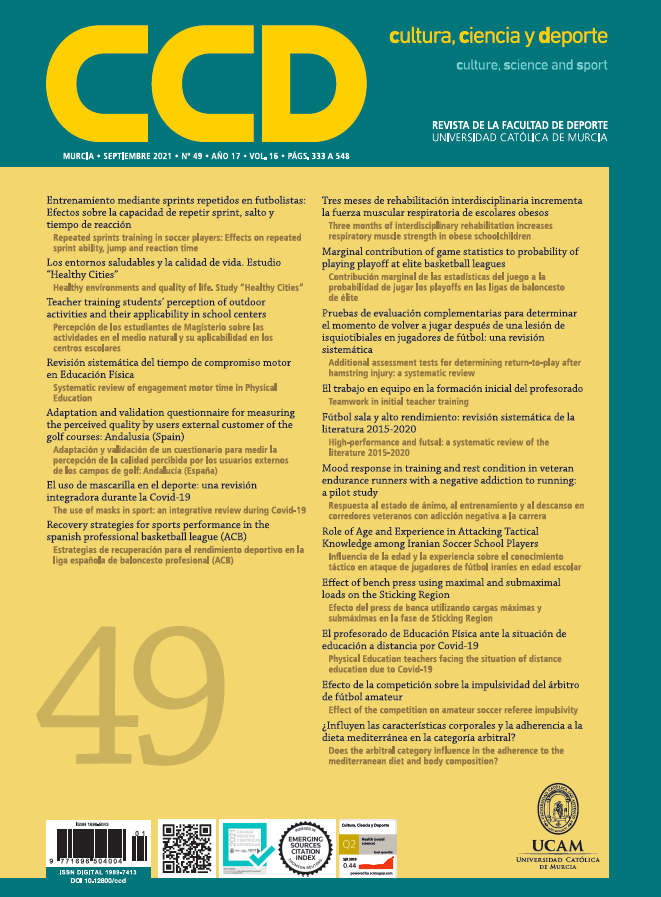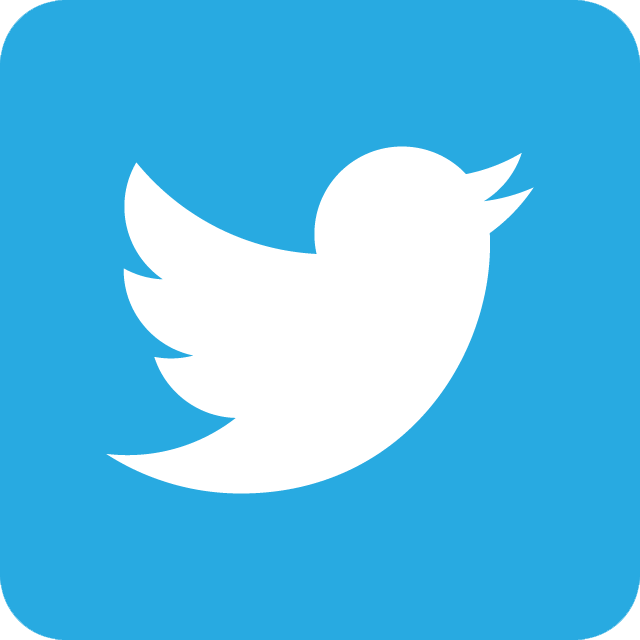The use of masks in sport: an integrative review during Covid-19
DOI:
https://doi.org/10.12800/ccd.v16i49.1554Keywords:
Mascarilla, deporte, hipoxia, hipercapnia, ETM, COVID-19Abstract
The use of the mask in the sports field has been studied to improve the athlete’s performance and its protection against a contaminated environment, such as the one existing in the current pandemic panorama of Covid-19. This review analyzes the impact of the mask on different physiological factors while doing physical exercise. A random selection was made of 2,420 studies published in Scholar Google, 118 in SCOPUS and 137 studies published in WOS between the periods 2016-2020, with 95% confidence and +/- 4.3 sampling error, which served for the selection and final analysis of 10 studies chosen intentionally following CTFPHC levels of evidence and the methodological rigor of a structured classification system called PEDro Scale. The results highlight that the use of masks in athletes causes hypoxic and hypercapnic breathing at a certain intensity; the use of masks such as the Elevation Training Mask (ETM) trains the respiratory muscles but does not improve lactic anaerobic performance as intermittent hypoxic training (IHT) does in height. It is discussed about hypoxia and hypercapnia conditions and the use of masks to improve physical performance in athletes.
References
Bellovary, B.N., King, K.E., Nunez, T.P., Mccormick, J.J., Wells, A.D., Bourbeau, K.C., Fennel, Z.J., Li, Z., Johnson, K.E., Moriarty, T., y Mermier, C.M. (2019). Effects of high-intensity interval training while using a breathing-restrictive mask compared to intermittent hypobaric hypoxia. Journal of Human Sport and Exercise, 14(4), 821-833. doi:10.14198/jhse.2019.144.11
Birtwhistle, R., Pottie, K., Shaw, E., Dickinson, J.A., Brauer, P., Fortin, M., Bell, N., Singh, H., Tonelli, M., Connor,S., Lewin, G., Joffres, M., y Parkin, P. (2012). Canadian Task Force on Preventive Health Care: we're back! Canadian Family Physician, 58, 13-5.
Bourouiba, L. (2020). Turbulent Gas Clouds and Respiratory Pathogen Emissions Potential Implications for Reducing Transmission of COVID-19. JAMA The Journal of the American Medical Association, 323(18), 1837-1838. doi:10.1001/jama.2020.4756
Chen, Y., Ebenstein, A.M., y Greenstone, H.L. (2013). Evidence on the impact of sustained exposure to air pollution on life expectancy from China’s Huai River policy, Proceedings of the National Academy of Sciences of the United States of America 110, 12936-12941.
Ciapponi, A. (2015). QUADAS-2: instrumento para la evaluación de la calidad de estudios de precisión diagnóstica. Revista Evidencia Actualización en la Práctica Ambulatoria, 18(1), 22-26.
Del Río Haza, F., López, O.G., Tobón, S.H., Leyva, P.D., y García, R.S. (2020). Los aerosoles y los virus. II. La física del contagio aéreo de la Covid-19. Departamento de Física, Universidad Autónoma Metropolitana, Iztapalapa.
Freemas, J.A., Wilhite, D.P, Greenshields, J.T., Adamic, E.M., y Mickleborough, T.D. (2020) Comparison between a facemask and mouthpiece on breathing mechanics and gas exchange variables during high-intensity exercise. European Journal of Sport Science, 20(2), 211-218, doi:10.1080/17461391.2019.1628309
Guo, M., Fu, S. (2019). Running With a Mask? The Effect of Air Pollution on Marathon Runners’ Performance. Journal of Sports Economics, 20(7), 903-928. doi:10.1177/1527002518822701
Hutton, B., Salanti, G., Caldwell, D. M., Chaimani, A., Schmid, C. H., Cameron, C., Loannidis, J. P. A., Straus, S., Thorlund, K., Jansen, J. P., Mulrow, C., Catalá-López, F., Gøtzsche, P. C., Dickersin, K., Boutron, I., Altman, D. A., y Moher, D. (2015). The PRISMA extension statement for reporting of systematic reviews incorporating network meta-analyses of health care interventions: Checklist and explanations PRISMA extension for network meta-analysis. Annals of Internal Medicine, 162(11), 777-784. doi:10.7326/M14-2385
Jung, H.C., Lee, N.H., John, S.D., y Lee, S. (2019). The elevation training mask induces modest hypoxaemia but does not affect heart rate variability during cycling in healthy adults. Biology of Sport, 36(2), 105-112. doi:10.5114/biolsport.2019.79976
Kao, T. W., Huang, K. C., Huang, Y. L., Tsai, T. J., Hsieh, B. S., y Wu, M. S. (2004). The physiological impact of wearing an N95 mask during hemodialysis as a precaution against SARS in patients with end-stage renal disease. Journal of the Formosan Medical Association, 103(8), 624–628.
Leung, N., Chu, D., Shiu, E., Chan, K. H., McDevitt, J. J., Hau, B., Yen, H. L., Li, Y., Ip, D., Peiris, J., Seto, W. H., Leung, G. M., Milton, D. K., y Cowling, B. J. (2020). Respiratory virus shedding in exhaled breath and efficacy of face masks. Nature medicine, 26(5), 676–680. doi:10.1038/s41591-020-0843-2
National Institute of Occupational Safety and Health (NIOSH). (2020). Approval Support, Test Procedures, Standards, and User Notices. Department of Health & Human Services, U.S.A. Recuperado de https://www.cdc.gov/niosh/npptl/respmanuf.html
Organización Mundial de la Salud. (2020). Advice on the use of masks in the context of COVID-19: interim guidance, 5 June 2020. World Health Organization. Recuperado de https://apps.who.int/iris/handle/10665/332293
Pifarré, F., Zabala, D.D., Grazioli, G., y Maura, I. D. (2020). COVID 19 and mask in sports. Apunts Sports Medicine. doi:10.1016/j.apunsm.2020.06.002
Porcari, J.P., Probst, L., Forrester, K., Doberstein, S., Foster, C., Cress, M.L., y Schmidt, K. (2016). Effect of wearing the elevation training mask on aerobic capacity, lung function, and hematological variables. Journal of Sports Science and Medicine, 15(2), 379-386.
Pun, V. C., J. y Manjouride, H.S. (2017). Association of ambient air pollution with depressive and anxiety symptoms in older adults: results from the NSHAP study. Environmental Health Perspectives 125, 342-348.
Rundell, K. W. (2012). Effect of air pollution on athlete health and performance. British Journal of Sports Medicine 46, 407-412.
Sellers, J.H., Monaghan, T.P., Schnaiter, J.A., Jacobson, B.H., y Pope, Z.K. (2016). Efficacy of a Ventilatory Training Mask to Improve Anaerobic and Aerobic Capacity in Reserve Officers' Training Corps Cadets. Journal of Strength and Conditioning Research, 30(4), 1155-1160. doi:10.1519/JSC.0000000000001184
Tobin, B., Costalat, G., y Renshaw, G.M.C. (2020). Intermittent not continuous hypoxia provoked haematological adaptations in healthy seniors: hypoxic pattern may hold the key. European Journal of Applied Physiology, 120, 707–718. doi:10.1007/s00421-020-04310-y
Toresdahl B.G. y Asif, I.M. (2020). Coronavirus Disease 2019 (COVID-19): Considerations for the Competitive Athlete. Sports Health, 12(3), 221‐224. doi:10.1177 / 1941738120918876
Wagner, D.R. y Clark, N.W. (2016). Similar results for face mask versus mouthpiece during incremental exercise to exhaustion. Journal of Sports Sciences, 34(9), 852-855.
Whittemore, R, Chao, A, Jang, M., Minges, K.E., y Park, C. (2014). Methods for knowledge synthesis: an overview. Heart Lung,43(5), 453-61. doi:10.1016/j.hrtlng.2014.05.014
Wong, A. Y., Ling, S. K., Louie, L. H., Law, G. Y., So, R.C., Lee, D.C., Yau, F.C., y Yung, P.S. (2020). Impact of the COVID-19 pandemic on sports and exercise. Asia-Pacific Journal of Sports Medicine, Arthroscopy, Rehabilitation and Technology, 22, 39-44. doi:10.1016/j.asmart.2020.07.006
Zhou, B., Costa, A. B., y Lukowicz, P. (2020). Accurate spirometry with integrated barometric sensors in face-worn garments. Sensors (Switzerland), 20(15), 1-22. doi:10.3390/s20154234
Zhu, N., Zhang, D., Wang, W., Li, X., Yang, B., Song, J., Zhao, X., Huang, B., Shi, W., Lu, R., Niu, P., Zhan, F., Ma, X., Wang, D., Xu, W., Wu, G., Gao, G. F., Tan, W., y China Novel Coronavirus Investigating and Research Team (2020). A Novel Coronavirus from Patients with Pneumonia in China, 2019. The New England journal of medicine, 382(8), 727–733. doi:10.1056/NEJMoa2001017
Downloads
Published
How to Cite
Issue
Section
License
Copyright (c) 2021 Creative Commons Attribution License

This work is licensed under a Creative Commons Attribution-NonCommercial-ShareAlike 4.0 International License.
The authors who publish in this journal agree with the following terms:
- The authors retain the copyright and guarantee the journal the right to be the first publication of the work as well as licensed under a Creative Commons Attribution License that allows others to share the work with recognition of the authorship of the work and the initial publication in this journal.















